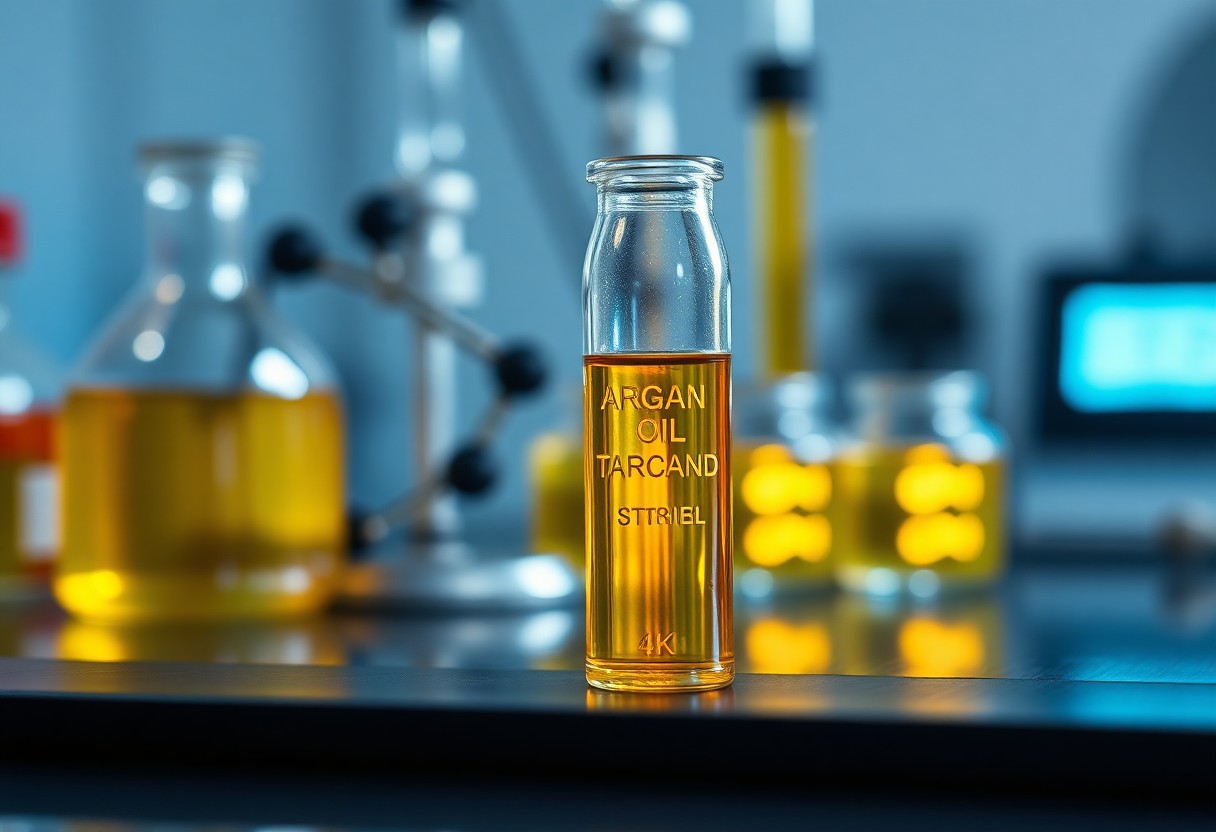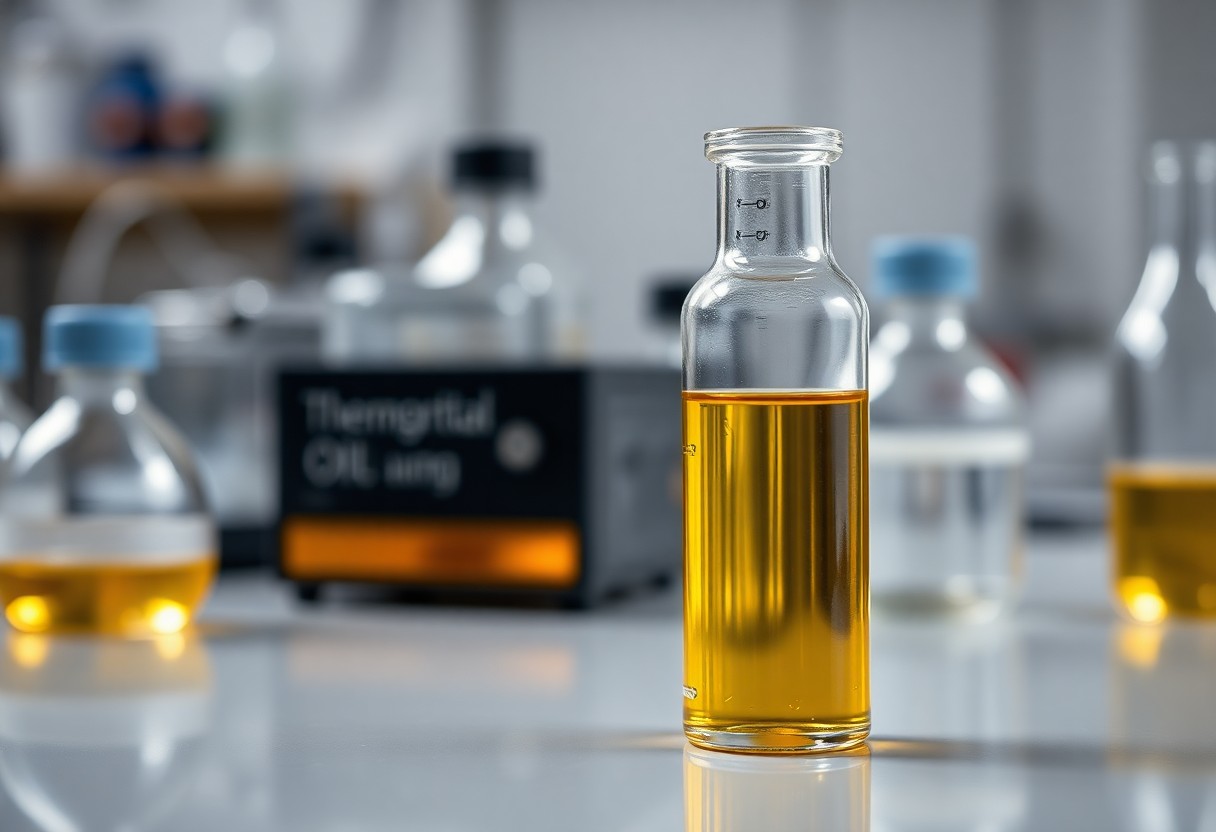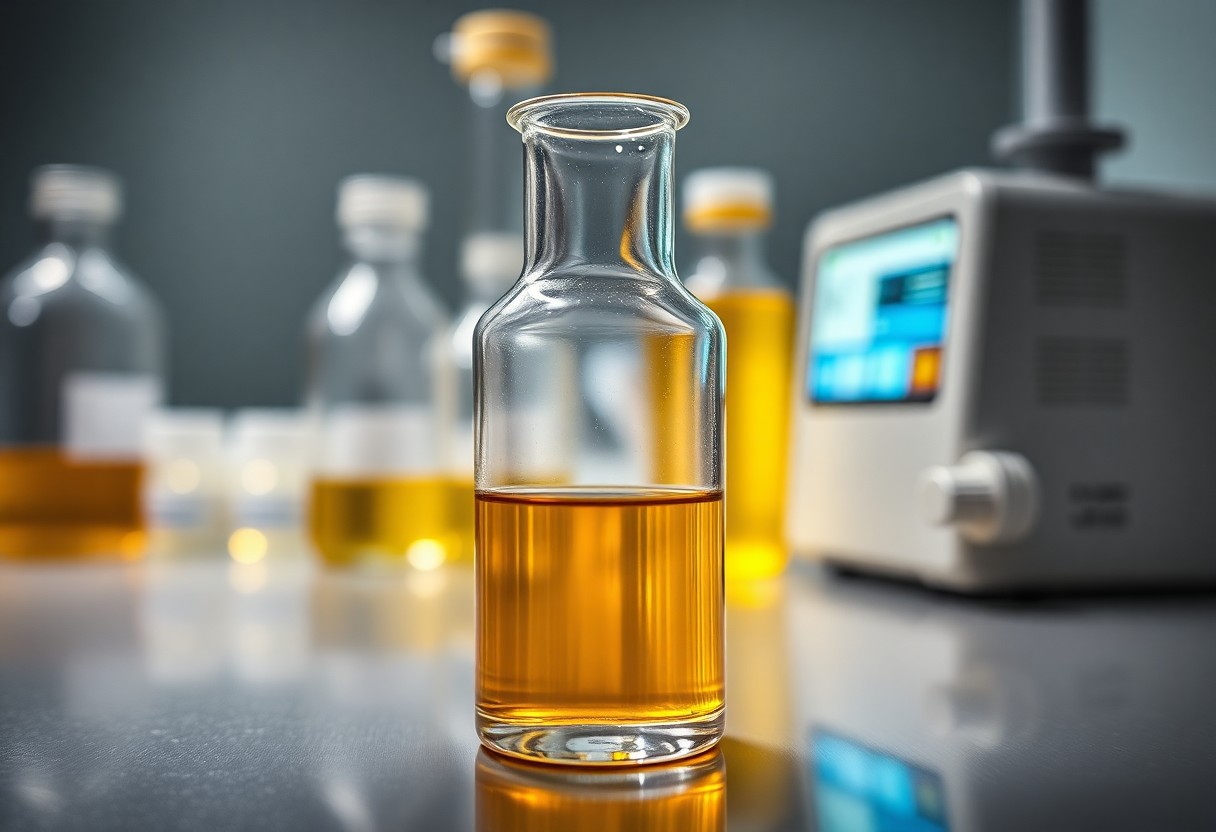There’s a fascinating interplay of chemistry and nature within argan oil that merits your attention. Understanding the unsaponifiable fraction, its composition, and its impact on thermal stability can enhance your appreciation for this remarkable oil. By delving into the science behind argan oil, you can unlock the secrets to its longevity against heat and its myriad benefits for your skin and hair. Join us as we explore how these components work together to create a robust product that stands the test of time.
Key Takeaways:
- Unsaponifiable Fraction: Argan oil contains a unique unsaponifiable fraction that contributes significantly to its properties and effectiveness.
- Thermal Stability: The presence of this unsaponifiable fraction enhances the thermal stability of argan oil, making it resistant to heat degradation.
- Skin Benefits: Due to its thermal stability, argan oil retains its beneficial properties even when exposed to high temperatures, making it suitable for cooking and cosmetic formulations.
- Antioxidant Properties: The unsaponifiable components of argan oil are rich in antioxidants, which help protect the oil from oxidative damage when heated.
- Versatility: Increased thermal stability allows argan oil to be used in diverse applications, from culinary uses to skincare and haircare products.
Understanding Argan Oil
The remarkable properties of argan oil stem from its unique composition, which largely contributes to its effectiveness in various applications, from skincare to culinary uses. Extracted from the nuts of the argan tree, native to Morocco, this oil is rich in fatty acids, antioxidants, and vitamins. You will find that it importantly comprises oleic acid and linoleic acid, both of which contribute to its moisturizing and nourishing capabilities. Furthermore, the phenolic compounds present in argan oil enhance its oxidative stability, ensuring that the oil retains its integrity better than many other natural oils, particularly when subjected to heat. This stability is important for those who wish to enhance their beauty routine without compromising the overall quality of the product being used.
Composition and Properties
To truly appreciate the benefits of argan oil, one must explore into its rich composition. You may be surprised to learn that argan oil consists of up to 80% unsaturated fatty acids, making it an excellent choice for maintaining healthy cell membranes and promoting efficient cellular function. Additionally, the presence of tocopherols, notably vitamin E, provides it with remarkable antioxidant properties. These characteristics not only serve to nourish your skin, but also work to protect it against free radical damage. With a balanced ratio of fatty acids, vitamins, and minerals, argan oil exhibits properties that transcend simple cosmetic utility and enter therapeutic potential.
The Role of Unsaponifiable Fraction
Little do many realize, the unsaponifiable fraction of argan oil plays a significant role in its effectiveness and thermal stability. This fraction contains a variety of bioactive compounds, including triterpenoids and sterols, which contribute to the oil’s anti-inflammatory and antioxidant properties. These components provide a protective barrier for the fatty acids, helping to anchor and stabilize the oil’s structure, which is particularly beneficial during heating. As you explore the many applications of argan oil, understanding the importance of its unsaponifiable fraction may afford you deeper insights into how this oil can be utilized effectively in your daily routine.
This unique aspect of argan oil not only influences its thermal stability but also enhances its overall efficacy in skincare and culinary applications. The unsaponifiable fraction works synergistically with the fatty acids to fortify the oil’s resilience against oxidation, thereby ensuring that the beneficial properties remain intact. As you integrate argan oil into your regimen, take comfort in the knowledge that its unsaponifiable compounds are a key element of its performance, helping to protect your skin and hair while providing nourishment at the molecular level.

Thermal Stability
One aspect that you might find fascinating in the context of argan oil’s performance is its thermal stability. This characteristic is pivotal when considering how oil behaves in application, especially under varying temperatures. Research highlighted in the article on the Oxidative Stability of Virgin and Refined Argan [Argania … researchs into the unsaponifiable fraction of argan oil, suggesting that this unique composition contributes significantly to its thermal stability. When subjected to heat, the stability of an oil can influence its nutritional profile, flavor, and safety for your consumption or application.
What is Thermal Stability?
Thermal stability refers to the oil’s ability to remain unchanged or resist degradation when exposed to high temperatures. This measure is necessary for understanding how oils, including argan oil, perform during cooking, cosmetic formulation, or even in storage. An oil high in thermal stability can resist breakdown, oxidative rancidity, and maintain its beneficial properties over time.
Factors Affecting Thermal Stability
Factors that influence the thermal stability of oils are many and varied. You might consider the quality and specific chemical composition of the oil, which can determine how it reacts under heat. Various aspects include:
- The presence of antioxidants that combat oxidative reactions
- Fatty acid profiles that may vary between oil types
- Environmental conditions such as exposure to light, heat, and air during storage
Recognizing the interplay of these factors can greatly enhance your understanding of how to select and utilize oils effectively in your culinary or cosmetic endeavors.
Another dimension to take into account is the extraction method of the oil, which can either enhance or diminish its thermal stability. Different extraction processes may result in varied concentrations of beneficial compounds, affecting stability during heat exposure. Important considerations include:
- Cold-pressed versus refined extraction methods
- Additives or preservatives introduced during processing
- Storage and handling practices that can influence oxidation
Recognizing these influences will empower you to make informed choices when selecting argan oil for your specific needs, ensuring that you benefit from its properties most effectively.

How to Assess Argan Oil’s Stability
Notably, assessing the stability of argan oil is an intricate process that demands a comprehensive approach. The stability of an oil hinges on various factors, including its composition and the presence of unsaponifiable fractions that may contribute to thermal resilience. To gain insightful revelations into your chosen argan oil, you can adopt several experimental methodologies that will unveil its stability profile and provide clarity regarding its thermal endurance under diverse conditions.
Key Tests and Methods
Any examination of argan oil’s stability may incorporate the use of various testing methods such as oxidative stability tests, thermal stability assessments, and the analysis of free fatty acids. Through oxidative stability tests, you can determine the oil’s susceptibility to oxidation, measuring the formation of peroxides and other degraded products over time. Thermal stability assessments involve subjecting your oil to elevated temperatures to observe any changes that may arise, such as color alteration or the emergence of off-odors. Additionally, analyzing free fatty acids can provide insights into the oil’s breakdown and degradation, giving you a holistic understanding of its stability.
Interpreting Results
Stability assessments reveal profound insights into the integrity of your argan oil. When you interpret the results, consider aspects such as the induction time from oxidative stability tests; a longer induction time generally indicates greater stability. Furthermore, pay attention to the outcomes of thermal assessments; minimal changes in properties suggest that your oil retains its beneficial characteristics under high temperatures. Such analysis is paramount, as it informs you about the potential usability and shelf life of your argan oil in various formulations.
A thoughtful interpretation necessitates an understanding of the various benchmarks and standards to compare your results against. For instance, if your argan oil presents a high percentage of unsaponifiable fractions, it may suggest its superior thermal stability and resilience against oxidation. Thus, understanding the nuances of these test results is instrumental in ascertaining the oil’s stability, enabling you to make informed decisions about its applications in cosmetic formulations.
Tips for Utilizing Argan Oil
Your journey into the world of argan oil can be immensely rewarding if you are aware of its most effective applications. You can harness its remarkable properties by following some practical tips. Here are a few suggestions to help you maximize the benefits of this exceptional oil:
- Apply argan oil to damp hair to seal in moisture and enhance shine.
- Use it as a base for homemade facial serums or moisturizers.
- Dab a small amount onto dry skin or cuticles to provide a nourishing boost.
- Incorporate it into your cooking for a nutty flavor and added health benefits.
- Avoid overheating the oil to maintain its thermal stability and nutritional profile.
Thou can easily integrate argan oil into various aspects of your daily routine to experience its myriad advantages.
Best Practices for Use
To truly appreciate the potential of argan oil, you should consider the method of application that best suits your needs. Whether you are using it for hair care, skin hydration, or culinary delights, employing the right technique can amplify its benefits. For hair, a few drops massaged through the strands can dramatically improve texture and manageability. When using it for skin, ensure that the surface is clean; this will allow for better absorption and efficacy.
To achieve the most effective results, consistency is paramount. Incorporating argan oil into your routine on a daily basis will yield more observable improvements over time. Be patient; visible effects often require a commitment to regular use. Keep in mind that simplicity can often be eloquent; a single drop is sometimes all you need to experience the beneficial effects without overwhelming your skin or hair.
Storage Recommendations
Any exploration of argan oil’s properties will lead you to consider the appropriate ways to store it. Preserving the integrity of the oil is imperative for maintaining its effectiveness. You should store your argan oil in a cool, dark place, away from direct sunlight and heat sources to minimize oxidation. Use a dark glass bottle if possible, as it provides an extra layer of protection against light, which can degrade the oil’s quality over time.
This approach ensures that the unsaponifiable fraction, which contributes to its thermal stability, remains potent. Additionally, avoid transferring argan oil between multiple containers to prevent contamination. A tight-sealed bottle will ideally keep the oil fresh for a more extended period, allowing you to enjoy its full range of benefits. Thou will find that the time and effort put into proper storage yield exceptionally rewarding results in your utilization of this remarkable oil.

Enhancing Stability in Formulations
Despite the inherent benefits of Argan oil, stabilizing it within various formulations can present challenges, particularly when considering thermal stability. The unsaponifiable fraction of Argan oil has been identified as a pivotal component contributing to its resilience against thermal degradation. A deeper understanding of this aspect can be gleaned from research on the subject, such as the findings presented in Argan Oil: Chemical Composition, Extraction Process, and … where the intricacies of this oil’s components are explored in detail. By appreciating the role of the unsaponifiable fractions, you can enhance formulations not just in stability but also in efficacy.
Combining Ingredients Wisely
One of the most effective strategies to optimize the thermal stability of your formulations involves the careful selection and combination of ingredients. When you mix Argan oil with synergistic natural extracts or compounds, you can create a formulation that not only maintains stability under heat but also amplifies the benefits of each ingredient. Ensure to conduct proper testing to evaluate how these ingredients interact with Argan oil, and adjust the ratios accordingly to achieve optimal results.
Avoiding Common Pitfalls
Ingredients used in your formulations can either bolster or undermine the stability of Argan oil. Therefore, you must be wary of selecting heat-sensitive elements that can easily deteriorate in high temperatures. Additionally, the concentration of each ingredient must be judiciously measured. Too much of a particular compound can lead to instability in the overall mix, compromising the advantages of the unsaponifiable fraction.
Plus, it’s important to stay informed about the shelf life and storage conditions of your ingredients. Frequent exposure to higher temperatures and direct sunlight can hasten chemical degradation, resulting in a less effective formulation. By ensuring the proper conditions and avoiding the aforementioned pitfalls, you can fully harness the thermal stability of Argan oil and its unique properties in your cosmetic or therapeutic products.
Practical Applications of Argan Oil
Now that you understand the remarkable properties of argan oil, it’s fascinating to explore its practical applications across various realms. From its role in cosmetics to culinary uses, argan oil demonstrates versatility and effectiveness. Research indicates that the unsaponifiable fraction of argan oil may contribute to its thermal stability, making it suitable for various applications. For a deeper understanding of this subject, you may find insights in the paper on Chemical Changes in Extra Virgin Argan Oil after Thermal …. By harnessing the unique properties of argan oil, you can enhance both your beauty regimen and your cooking practices.
In Cosmetics
Little did you know that argan oil has been celebrated for its ability to nourish, hydrate, and rejuvenate your skin and hair. Its rich composition of fatty acids makes it an effective moisturizer, while the high levels of antioxidants protect your skin from environmental damage. You may find that using argan oil in your skincare routine not only improves your complexion but also provides a youthful glow. Many cosmetic brands incorporate this liquid gold into their products, further attesting to its efficacy.
In Culinary Uses
Clearly, you stand to benefit from incorporating argan oil into your culinary practices, as it adds a rich and nutty flavor to your dishes while delivering imperative nutrients. Traditionally used in Moroccan cuisine, this oil pairs beautifully with salads, vegetables, and dips, elevating the overall taste profile. Furthermore, argan oil is known for its health benefits, including promoting heart health due to its monounsaturated fats.
It offers a unique ingredient that not only enhances flavor but also provides nutritional advantages, making it a delightful addition to your kitchen. Whether you are drizzling it atop roasted vegetables or using it as a base for dressings, incorporating argan oil into your diet can transform your meals into something extraordinary while ensuring you reap its array of benefits.
Final Words
On the whole, your exploration into the unsaponifiable fraction of argan oil reveals a fascinating interplay between its composition and thermal stability. As you explore into the scientific intricacies, you uncover how this unique fraction interacts with heat and maintains the integrity of the oil. This opens up new avenues for considering how natural products can withstand the rigors of culinary and cosmetic applications without degrading their beneficial properties. The confluence of chemistry and practicality invites you to rethink the oils you choose, as you become increasingly attuned to the value of their constituents.
Ultimately, your quest for knowledge positions you at the intersection of food science and personal well-being. By embracing argan oil and its unsaponifiable components, you find yourself harnessing nature’s wisdom in a bottle. You not only enhance your dishes and skincare regimen but also engage in a broader dialogue about sustainability and the benefits of natural ingredients. As you integrate such insights into your life, you invite a greater understanding of the world’s natural resources, fostering your appreciation for the complex yet harmonious relationships found in nature.
FAQ
Q: What is the unsaponifiable fraction of argan oil?
A: The unsaponifiable fraction of argan oil refers to the components that do not form soap when mixed with an alkaline solution. This fraction comprises various bioactive compounds, including sterols, tocopherols, and phenolic compounds, which contribute to the oil’s unique properties. It is distinct from the saponifiable fraction, which includes triglycerides that can be converted into soap.
Q: How does the unsaponifiable fraction contribute to the thermal stability of argan oil?
A: The unsaponifiable fraction contributes to the thermal stability of argan oil by acting as an antioxidant. These compounds help protect the oil from oxidative degradation when exposed to heat. By minimizing the formation of free radicals and other harmful byproducts during cooking or cosmetic applications, the unsaponifiable fraction plays a role in maintaining the quality and integrity of the oil under thermal stress.
Q: Can the unsaponifiable fraction of argan oil enhance its shelf life?
A: Yes, the unsaponifiable fraction can enhance the shelf life of argan oil. Due to its antioxidant properties, it helps inhibit rancidity and prolongs the stability of the oil during storage. This means that products containing argan oil may retain their beneficial properties for a longer period, making them suitable for both culinary and cosmetic uses.
Q: Are there specific components in the unsaponifiable fraction that are particularly beneficial?
A: Yes, several components within the unsaponifiable fraction are beneficial. For example, tocopherols (vitamin E) are well-known antioxidants that protect against oxidative stress, while sterols may promote skin health and offer anti-inflammatory effects. These constituents synergistically enhance the thermal stability and overall efficacy of argan oil.
Q: How does the thermal stability of argan oil compare to other oils?
A: Argan oil is generally recognized for having good thermal stability, primarily due to its unsaponifiable fraction. Compared to oils with a higher ratio of polyunsaturated fatty acids, like flaxseed oil, argan oil tends to be less prone to oxidation at higher temperatures. This makes it a preferable choice for both cooking and skin care applications where heat is involved.

